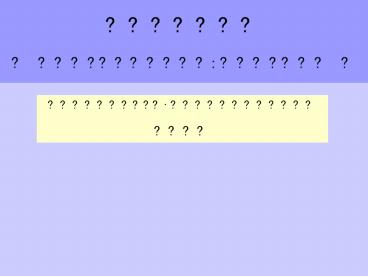Superconducting Order Parameter of Sr2RuO4:an Exprimental Overview - PowerPoint PPT Presentation
Title:
Superconducting Order Parameter of Sr2RuO4:an Exprimental Overview
Description:
Title: Superconducting Order Parameter of Sr2RuO4 an Exprimental Overview Author: Maeno Last modified by: Maeno Created Date: 8/24/2002 7:15:42 AM – PowerPoint PPT presentation
Number of Views:101
Avg rating:3.0/5.0
Title: Superconducting Order Parameter of Sr2RuO4:an Exprimental Overview
1
???????? ?????????????????? ?
?????????????????????? ????
2
???????????????? ??1
1910 ????????????? ???-??-????
1913 ??????????????????????????? ?????-???
(????)
1920 (???) ???????? ?????
1949(???) ??????????? ??????????????????? ????
3
???????
????????????????????????????????
???????????????????????????(????)?
??????? ??????????
?????????????????
4
??????
???????????????????????
????????? ???????!
1911???? ??????? (????) 1913?? ?????
5
???????
??2?????????????????????????
1. ???????
????Tc (????)
6
???????????????? ??2
1962 ???????????? ????
1972 ??????????? (BCS??) ?????? ???? ???????
1973 (???????)?????????????????? (??
???)?????? ??????
1978 ????????????????????????????? ?????
7
?????????
? ? ?? ??? ? ???(??)
??????????????????????????????
????(?????)???????????????????????????????????
8
BCS???????
Bardeen, Cooper, Schrieffer (1957)
??-???????????? ?????????? ????? P 0, ????? S
0 ??????????
????????????????????? ? ????.
9
????????
?????????????? ?????????????????
????????????????????
10
??????????????? ??3
103?? 19? / 171?(11)
1987 ???????????? K.A.???? J.G.?????
1996 ???????3??? ??????????????
10?
2001 ?????????????????????????? ???? ?????????
2003 ???????????????????? A.A.?????? (???)
V.L. ?????? (???) A.J. ???? (????)
11
????????(1986?)
????????? d?????
????????????
12
?????????????????????
BEC of alkaline gases by laser cooling M.H.
Anderson et al., Science 269, 198 (1995).
87Rb (Z 37), TBEC 170 mK, n 2.5 x 1012
cm-3 also in 7Li, 23Na, 85Rb
13
The Nobel Prize in Physics 2003
"for pioneering contributions to the theory of
superconductors and superfluids"
Anthony J. Leggett
Vitaly L. Ginzburg
Alexei A. Abrikosov
United Kingdom and USA
Russia
USA and Russia
University of Illinois Urbana, USA
P.N. Lebedev Physical Institute Moscow, Russia
Argonne National Laboratory USA
?????? ?????
????
?????
14
2???????
Type-I superconductors repel a magnetic field
(the Meissner effect). If the strength of the
magnetic field increases, they lose their
superconductivity. This does not happen with
type-II superconductors, which accomodate strong
magnetic fields by letting the magnetic field in.
Ginzburg-Landau???
15
??????????
This image is of an Abrikosov lattice of vortices
in the electron fluid in a type-II
superconductor. The magnetic field passes through
these vortices.
16
???????4??????
???????????????????????? E.J. Yarmchuck, and
R.E. Packard
???????? ???????
17
??????????
The pair formation that occurs in superfluid 3He
differs from that which occurs between electrons
in a superconductor (Cooper pairs).
18
????????????????
??????(?, ?)??? ??????????????2?????
19
???????????????????S 1 Cooper pairing
(0) ??????? 3He p-wave
(1) ????????? UPt3 UNi2Al3UPd2Al3
???????? (2) ???????????? Sr2RuO4 (3)
???????????? UGe2, URhGe, ZrZn2? (4) ??????
(TMTSF)2PF6 ?? (5) ??? PrOs4Sb12? ,
NaxCoO2?yH2O?
???????????????????????????????????Sr2RuO4?????!
20
?????????? Sr2RuO4??????????
??????? Tc 1.5 K
??? ?????? (Sz 0) ??? ?????? (Lz 1)
21
????????
- ????Tc???
- ?????????
(2) ????????????? BCS?????????????????
(3) ??????????? ??-??????????? ?s????? FFLO
(4) ????????? ????????????????????????
22
(No Transcript)
23
??????
24
????(?s?)???????
??????????????(??????) ??????????????????s????
Cu?????????? ? ??????? ? ??????d????
Ru??? ??????? ???? ???? ? ????????
??????
????????????? ??????????? ??????































